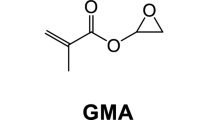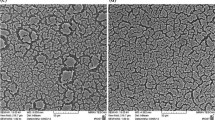Abstract
Although already some mesoporous (2–50 nm) sol–gel TiO2 synthesis strategies exist, no pore size control beyond the 12 nm range is possible without using specialized organic structure-directing agents synthetized via controlled anionic/radical polymerizations. Here, we present the use of reversible addition–fragmentation chain transfer (RAFT) polymerization as a straightforward and industrial applicable alternative to the existing controlled polymerization methods for structure-directing agent synthesis. Poly(N,N-dimethylacrylamide)-block-polystyrene (PDMA-b-PS) block copolymer, synthesized via RAFT, was chosen as structure-directing agent for the formation of the mesoporous TiO2. Crack-free thin layers TiO2 with tunable pores from 8 to 45 nm could be acquired. For the first time, in a detailed and systematic approach, the influence of the block size and dispersity of the block copolymer is experimentally screened for their influence on the final meso-TiO2 layers. As expected, the mesoporous TiO2 pore sizes showed a clear correlation to the polystyrene block size and the dispersity of the PDMA-b-PS block copolymer. Surprisingly, the dispersity of the polymer was shown not to be affecting the standard deviation of the pores. As a consequence, RAFT could be seen as a viable alternative to the aforementioned controlled polymerization reactions for the synthesis of structure-directing agents enabling the formation of mesoporous pore size-controlled TiO2. To examine the photocatalytic activity of the mesoporous TiO2 thin layers, the degradation of acetaldehyde, a known indoor pollutant, was studied. Even after 3 years of aging, the TiO2 thin layer retained most of its activity.







Similar content being viewed by others
References
Li W, Wu ZX, Wang JX, Elzatahry AA, Zhao DY (2014) A perspective on mesoporous TiO2 materials. Chem Mater 26(1):287–298. https://doi.org/10.1021/cm4014859
Yang PD, Zhao DY, Margolese DI, Chmelka BF, Stucky GD (1998) Generalized syntheses of large-pore mesoporous metal oxides with semicrystalline frameworks. Nature 396(6707):152–155. https://doi.org/10.1038/24132
Taguchi A, Schuth F (2005) Ordered mesoporous materials in catalysis. Microporous Mesoporous Mater 77(1):1–45. https://doi.org/10.1016/j.micromeso.2004.06.030
Smarsly B, Grosso D, Brezesinski T, Pinna N, Boissiere C, Antonietti M, Sanchez C (2004) Highly crystalline cubic mesoporous TiO2 with 10-nm pore diameter made with a new block copolymer template. Chem Mater 16(15):2948–2952. https://doi.org/10.1021/cm0495966
Liu B, Louis M, Jin L, Li GH, He J (2018) Co-template directed synthesis of gold nanoparticles in mesoporous titanium dioxide. Chem Eur J 24(38):9651–9657. https://doi.org/10.1002/chem.201801223
Cao SB, Zhao YB, Qu T, Wang PP, Guan S, Xu YW, Rao F, Li YY, Chen AH, Iyoda T (2016) Ordered mesoporous crystalline titania with high thermal stability from comb-like liquid crystal block copolymers. RSC Adv 6(61):55834–55841. https://doi.org/10.1039/c6ra10352a
Nakata K, Fujishima A (2012) TiO2 photocatalysis: design and applications. J Photochem Photobiol C Photochem Rev 13(3):169–189. https://doi.org/10.1016/j.jphotochemrev.2012.06.001
Verbruggen SW (2015) TiO2 photocatalysis for the degradation of pollutants in gas phase: from morphological design to plasmonic enhancement. J Photochem Photobiol C Photochem Rev 24:64–82. https://doi.org/10.1016/j.jphotochemrev.2015.07.001
Bach U, Lupo D, Comte P, Moser JE, Weissortel F, Salbeck J, Spreitzer H, Gratzel M (1998) Solid-state dye-sensitized mesoporous TiO2 solar cells with high photon-to-electron conversion efficiencies. Nature 395(6702):583–585. https://doi.org/10.1038/26936
Hagfeldt A, Boschloo G, Sun LC, Kloo L, Pettersson H (2010) Dye-sensitized solar cells. Chem Rev 110(11):6595–6663. https://doi.org/10.1021/cr900356p
Yi CY, Li X, Luo JS, Zakeeruddin SM, Gratzel M (2016) Perovskite photovoltaics with outstanding performance produced by chemical conversion of bilayer mesostructured lead halide/TiO2 films. Adv Mater 28(15):2964–2970. https://doi.org/10.1002/adma.201506049
Stefano RM, Thomas W (2013) Titania supported hydrodesulphurisation catalysts. Patent no EP2606972A1
Zhang Y, Yang QG, Yang XY, Deng YH (2018) One-step synthesis of in situ N-doped ordered mesoporous titania for enhanced gas sensing performance. Microporous Mesoporous Mater 270:75–81. https://doi.org/10.1016/j.micromeso.2018.04.008
Fischer MG, Hua X, Wilts BD, Gunkel I, Bennett TM, Steiner U (2017) Mesoporous titania microspheres with highly tunable pores as an anode material for lithium ion batteries. ACS Appl Mater Interfaces 9(27):22388–22397. https://doi.org/10.1021/acsami.7b03155
Li W, Wang F, Liu YP, Wang JX, Yang JP, Zhang LJ, Elzatahry AA, Al-Dahyan D, Xia YY, Zhao DY (2015) General strategy to synthesize uniform mesoporous TiO2/graphene/mesoporous TiO2 sandwich-like nanosheets for highly reversible lithium storage. Nano Lett 15(3):2186–2193. https://doi.org/10.1021/acs.nanolett.5b00291
Taffa DH, Kathiresan M, Walder L, Seelandt B, Wark M (2010) Pore size and surface charge control in mesoporous TiO2 using post-grafted SAMs. Phys Chem Chem Phys 12(7):1473–1482. https://doi.org/10.1039/b921743f
Fuertes MC, Marchena M, Marchi MC, Wolosiuk A, Soler-Illia G (2009) Controlled deposition of silver nanoparticles in mesoporous single- or multilayer thin films: from tuned pore fitting to selective spatial location of nanometric objects. Small 5(2):272–280. https://doi.org/10.1002/smll.200800894
Soler-Illia G, Azzaroni O (2011) Multifunctional hybrids by combining ordered mesoporous materials and macromolecular building blocks. Chem Soc Rev 40(2):1107–1150. https://doi.org/10.1039/c0cs00208a
Fattakhova-Rohlfing D, Zaleska A, Bein T (2014) Three-dimensional titanium dioxide nanomaterials. Chem Rev 114(19):9487–9558. https://doi.org/10.1021/cr500201c
Loreto S, Vanrompay H, Mertens M, Bals S, Meynen V (2018) The influence of acids on tuning the pore size of mesoporous TiO2 templated by non-ionic block copolymers. Eur J Inorg Chem 1:62–65. https://doi.org/10.1002/ejic.201701266
Meynen V, Cool P, Vansant EF (2009) Verified syntheses of mesoporous materials. Microporous Mesoporous Mater 125(3):170–223. https://doi.org/10.1016/j.micromeso.2009.03.046
Meire M, Verbruggen SW, Lenaerts S, Lommens P, Van Der Voort P, Van Driessche I (2016) Microwave-assisted synthesis of mesoporous titania with increased crystallinity, specific surface area, and photocatalytic activity. J Mater Sci 51(21):9822–9829. https://doi.org/10.1007/s10853-016-0215-y
Lokupitiya HN, Jones A, Reid B, Guldin S, Stefik M (2016) Ordered mesoporous to macroporous oxides with tunable isomorphic architectures: solution criteria for persistent micelle templates. Chem Mater 28(6):1653–1667. https://doi.org/10.1021/acs.chemmater.5b04407
Stefik M, Song J, Sai H, Guldin S, Boldrighini P, Orilall MC, Steiner U, Gruner SM, Wiesner U (2015) Ordered mesoporous titania from highly amphiphilic block copolymers: tuned solution conditions enable highly ordered morphologies and ultra-large mesopores. J Mater Chem A 3(21):11478–11492. https://doi.org/10.1039/c5ta02483h
Song L, Korstgens V, Magerl D, Su B, Froschl T, Husing N, Bernstorff S, Muller-Buschbaum P (2017) Low-temperature fabrication of mesoporous titania thin films. MRS Adv 2(43):2315–2325. https://doi.org/10.1557/adv.2017.406
Wei J, Li YH, Wang MH, Yue Q, Sun ZK, Wang C, Zhao YJ, Deng YH, Zhao DY (2013) A systematic investigation of the formation of ordered mesoporous silicas using poly(ethylene oxide)-b-poly(methyl methacrylate) as the template. J Mater Chem A 1(31):8819–8827. https://doi.org/10.1039/c3ta11469d
Nakatani H, Hamachi R, Fukui K, Motokucho S (2018) Synthesis and activity characteristics of visible light responsive polymer photocatalyst system with a styrene block copolymer containing TiO2 gel. J Colloid Interface Sci 532:210–217. https://doi.org/10.1016/j.jcis.2018.07.119
Xiao Y, You SS, Yao Y, Zheng T, Lin C, Roth SV, Muller-Buschbaum P, Steffen W, Sun LD, Yan CH, Gutmann JS, Yin MZ, Fu J, Cheng YJ (2013) Generalized synthesis of mesoporous rare earth oxide thin films through amphiphilic ionic block copolymer templating. Eur J Inorg Chem 8:1251–1257. https://doi.org/10.1002/ejic.201201524
Zhang Q, Lin JP, Wang LQ, Xu ZW (2017) Theoretical modeling and simulations of self-assembly of copolymers in solution. Prog Polym Sci 75:1–30. https://doi.org/10.1016/j.progpolymsci.2017.04.003
Lynd NA, Meuler AJ, Hillmyer MA (2008) Polydispersity and block copolymer self-assembly. Prog Polym Sci 33(9):875–893. https://doi.org/10.1016/j.progpolymsci.2008.07.003
Thomas A, Schlaad H, Smarsly B, Antonietti M (2003) Replication of lyotropic block copolymer mesophases into porous silica by nanocasting: learning about finer details of polymer self-assembly. Langmuir 19(10):4455–4459. https://doi.org/10.1021/la0340807
Baskaran D, Muller AHE (2007) Anionic vinyl polymerization—50 years after Michael Szwarc. Prog Polym Sci 32(2):173–219. https://doi.org/10.1016/j.progpolymsci.2007.01.003
Feng HB, Lu XY, Wang WY, Kang NG, Mays JW (2017) Block copolymers: synthesis, self-assembly, and applications. Polymers 9(10):31. https://doi.org/10.3390/polym9100494
Sarkar A, Evans L, Stefik M (2018) Expanded kinetic control for persistent micelle templates with solvent selection. Langmuir 34(20):5738–5749. https://doi.org/10.1021/acs.langmuir.8b00417
Moad G, Rizzardo E, Thang SH (2009) Living radical polymerization by the RAFT process—a second update. Aust J Chem 62(11):1402–1472. https://doi.org/10.1071/ch09311
Chiefari J, Chong YK, Ercole F, Krstina J, Jeffery J, Le TPT, Mayadunne RTA, Meijs GF, Moad CL, Moad G, Rizzardo E, Thang SH (1998) Living free-radical polymerization by reversible addition-fragmentation chain transfer: the RAFT process. Macromolecules 31(16):5559–5562. https://doi.org/10.1021/ma9804951
Keddie DJ (2014) A guide to the synthesis of block copolymers using reversible-addition fragmentation chain transfer (RAFT) polymerization. Chem Soc Rev 43(2):496–505. https://doi.org/10.1039/c3cs60290g
Destarac M (2018) Industrial development of reversible-deactivation radical polymerization: is the induction period over? Polym Chem 9(40):4947–4967. https://doi.org/10.1039/C8PY00970H
Minehara H, Pitet LM, Kim S, Zha RH, Meijer EW, Hawker CJ (2016) Branched block copolymers for tuning of morphology and feature size in thin film nanolithography. Macromolecules 49(6):2318–2326. https://doi.org/10.1021/acs.macromol.5b02649
Sarkar A, Stefik M (2017) How to make persistent micelle templates in 24 h and know it using X-ray scattering. J Mater Chem A 5(23):11840–11853. https://doi.org/10.1039/c7ta01034f
Bianchi A, Mauri M, Bonetti S, Koynov K, Kappl M, Lieberwirth I, Butt HJ, Simonutti R (2014) Hierarchical self-assembly of PDMA-b-PS chains into granular nanoparticles: genesis and fate. Macromol Rapid Commun 35(23):1994–1999. https://doi.org/10.1002/marc.201400414
Stefik M, Sai H, Sauer K, Gruner SM, DiSalvo FJ, Wiesner U (2009) Three-component porous–carbon–titania nanocomposites through self-assembly of ABCBA block terpolymers with titania sols. Macromolecules 42(17):6682–6687. https://doi.org/10.1021/ma900685e
Helms BA, Williams TE, Buonsanti R, Milliron DJ (2015) Colloidal nanocrystal frameworks. Adv Mater 27(38):5820–5829. https://doi.org/10.1002/adma.201500127
Zhang JY, Deng YH, Gu D, Wang ST, She L, Che RC, Wang ZS, Tu B, Xie SH, Zhao DY (2011) Ligand-assisted assembly approach to synthesize large-pore ordered mesoporous titania with thermally stable and crystalline framework. Adv Energy Mater 1(2):241–248. https://doi.org/10.1002/aenm.201000004
Ferguson CJ, Hughes RJ, Nguyen D, Pham BTT, Gilbert RG, Serelis AK, Such CH, Hawkett BS (2005) Ab initio emulsion polymerization by RAFT-controlled self-assembly. Macromolecules 38(6):2191–2204. https://doi.org/10.1021/ma048787r
Asapu R, Claes N, Bals S, Denys S, Detavernier C, Lenaerts S, Verbruggen SW (2017) Silver-polymer core–shell nanoparticles for ultrastable plasmon-enhanced photocatalysis. Appl Catal B Environ 200:31–38. https://doi.org/10.1016/j.apcatb.2016.06.062
Deng SR, Verbruggen SW, He ZB, Cott DJ, Vereecken PM, Martens JA, Bals S, Lenaerts S, Detavernier C (2014) Atomic layer deposition-based synthesis of photoactive TiO2 nanoparticle chains by using carbon nanotubes as sacrificial templates. RSC Adv 4(23):11648–11653. https://doi.org/10.1039/c3ra42928h
Verbruggen SW, Deng S, Kurttepeli M, Cott DJ, Vereecken PM, Bals S, Martens JA, Detavernier C, Lenaerts S (2014) Photocatalytic acetaldehyde oxidation in air using spacious TiO2 films prepared by atomic layer deposition on supported carbonaceous sacrificial templates. Appl Catal B Environ 160:204–210. https://doi.org/10.1016/j.apcatb.2014.05.029
Rijckaert H, Pollefeyt G, Sieger M, Hanisch J, Bennewitz J, De Keukeleere K, De Roo J, Huhne R, Backer M, Paturi P, Huhtinen H, Hemgesberg M, Van Driessche I (2017) Optimizing nanocomposites through nanocrystal surface chemistry: superconducting YBa2Cu3O7 thin films via low-fluorine metal organic deposition and preformed metal oxide nanocrystals. Chem Mater 29(14):6104–6113. https://doi.org/10.1021/acs.chemmater.7b02116
Harrisson S (2018) The downside of dispersity: why the standard deviation is a better measure of dispersion in precision polymerization. Polym Chem 9(12):1366–1370. https://doi.org/10.1039/C8PY00138C
Balajka J, Hines MA, DeBenedetti WJI, Komora M, Pavelec J, Schmid M, Diebold U (2018) High-affinity adsorption leads to molecularly ordered interfaces on TiO2 in air and solution. Science 361(6404):786–789. https://doi.org/10.1126/science.aat6752
Acknowledgements
Ghent University is acknowledged for funding the research presented in this paper. M. Meire and S. W. Verbruggen acknowledge the FWO-Flanders (Fund for Scientific Research-Flanders) for financial support. The authors thank Bernhard De Meyer for the SEC analysis, Hannes Rijckaert for the cross-sectional analysis, Tom Planckaert for BET analysis of the meso-TiO2 powders, Jeroen Kint for the porosi-ellipsometry tests and Frank Driessen for the MALDI-TOF analysis.
Author information
Authors and Affiliations
Corresponding author
Additional information
Publisher's Note
Springer Nature remains neutral with regard to jurisdictional claims in published maps and institutional affiliations.
Electronic supplementary material
Below is the link to the electronic supplementary material.
Rights and permissions
About this article
Cite this article
Billet, J., Vandewalle, S., Meire, M. et al. Mesoporous TiO2 from poly(N,N-dimethylacrylamide)-b-polystyrene block copolymers for long-term acetaldehyde photodegradation. J Mater Sci 55, 1933–1945 (2020). https://doi.org/10.1007/s10853-019-04024-3
Received:
Accepted:
Published:
Issue Date:
DOI: https://doi.org/10.1007/s10853-019-04024-3




